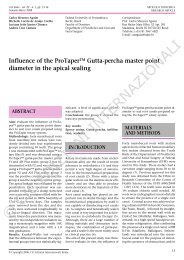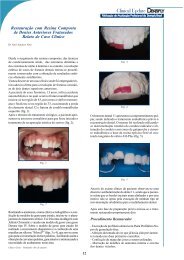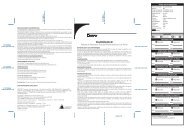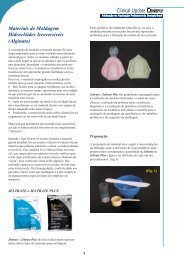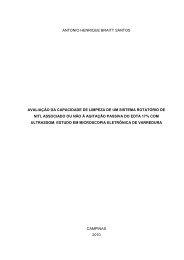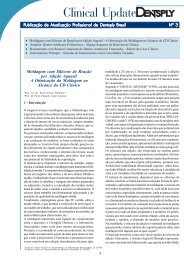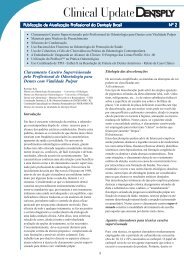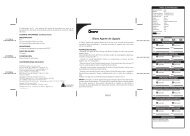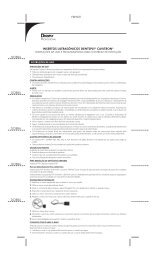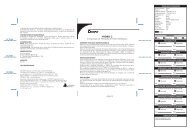Create successful ePaper yourself
Turn your PDF publications into a flip-book with our unique Google optimized e-Paper software.
Microleakage of XP Bond in Class II Cavities After<br />
Artificial Aging<br />
Jürgen Manhart a /Cordula Trumm b<br />
Purpose: To determine the microleakage of etch and rinse adhesives.<br />
Materials and Methods: Standardized Class II cavities were cut in 40 human molars with one proximal box limited<br />
within enamel and one proximal box extending into dentin. Teeth were assigned randomly to 5 groups (n = 8) and restored<br />
with incrementally placed composite restorations. Five combinations were tested: G1 = XP Bond + CeramX<br />
Mono, G2 = Syntac Classic + Tetric EvoCeram, G3 = Scotchbond 1 XT + Z250, G4 = P&B NT + CeramX Mono, G5 =<br />
Optibond Solo Plus + CeramX Mono. After finishing and polishing, teeth were stored for 48 h in water at 37°C before<br />
being subjected to artificial aging by thermal stress (5/55°C, 2000x, 30 s) and mechanical loading (50 N, 50,000x).<br />
Teeth were isolated with nail varnish and immersed in 5% methylene blue for 1 h. After sectioning, specimens were<br />
evaluated for leakage (ordinal scale: 0 to 4) at enamel and dentin margins under a stereomicroscope. Results were<br />
analyzed using the Kruskal-Wallis H-test and Mann-Whitney U-test (p < 0.05).<br />
Results: Statistical analysis showed significant differences among the groups in both enamel and dentin. Mean<br />
ranks (H-test) were: enamel: G2 (64.44) < G1 (66.69) < G4 (74.88) < G3 (98.25) and G5 (98.25); dentin: G3 (65.53) <<br />
G1 (74.42) < G4 (81.09) < G2 (81.84) < G5 (99.61).<br />
Conclusion: Microleakage of XP Bond is at the same level as or even better than other etch-and-rinse adhesives.<br />
Keywords: Class II restorations, dentin adhesives, composite, microleakage.<br />
J Adhes Dent 2007; 9: 261-264. Submitted for publication: 15.12.06; accepted for publication: 8.1.07.<br />
Despite improvements in the formulation of modern<br />
dentin adhesive systems, the bond strength and marginal<br />
adaptation of composite resins to dentin seems still inferior<br />
and less predictable than adhesion to enamel. 3,11<br />
However, most of the cavities in clinical dentistry, especially<br />
when restorations in the posterior region of the mouth are<br />
replaced, are not limited exclusively within enamel but show<br />
a mixed type configuration with finishing lines in both enamel<br />
and dentin. 3,12 In particular, the adhesive interface between<br />
tooth and restorative material at the gingival finish<br />
line has been recognized as one of the most problematic regions.<br />
5,9 While a great number of self-etching primers and<br />
adhesives have emerged on the market, which are considered<br />
less technique sensitive and less time consuming than<br />
etch-and-rinse adhesives, 13 the latter are still considered<br />
the gold standard with respect to long-term bond strength<br />
and marginal seal, especially for the restoration of highly<br />
loaded Class II cavities or when restorations are bonded to<br />
uninstrumented tooth tissues such as sclerotic dentin in<br />
Class V lesions or virgin enamel in anterior diastema closures.<br />
This study assesses the microleakage of a newly formulated<br />
etch-and-rinse adhesive, based on a tert-butanol solvent<br />
used for the first time, in large Class II cavities after artificial<br />
aging in comparison with well-established competitive<br />
adhesive and composite systems. The null hypothesis tested<br />
was that the type of restorative system used does not significantly<br />
affect the marginal seal.<br />
a Associate Professor, Department of Restorative Dentistry, Ludwig Maximilians<br />
University, Munich, Germany.<br />
b Dentist in Private Practice, Munich, Germany.<br />
Paper presented at Satellite Symposium on Dental Adhesives, Dublin,<br />
September 13th, 2006.<br />
Reprint requests: Dr. Jürgen Manhart, Department of Restorative Dentistry,<br />
Goethe Street 70, 80336 Munich, Germany. Tel: +49-89-5160-7610, Fax: +49-<br />
89-5160-9302. e-mail: manhart@manhart.com<br />
MATERIALS AND METHODS<br />
Specimen Preparation<br />
Forty freshly extracted caries-free human permanent molars,<br />
stored in a 0.25% mixture of sodium azide in Ringer solution<br />
until the date of use, were used in this in vitro study.<br />
After cleaning the teeth with scalers and polishing with<br />
Vol 9, Supplement 2, 2007 261



